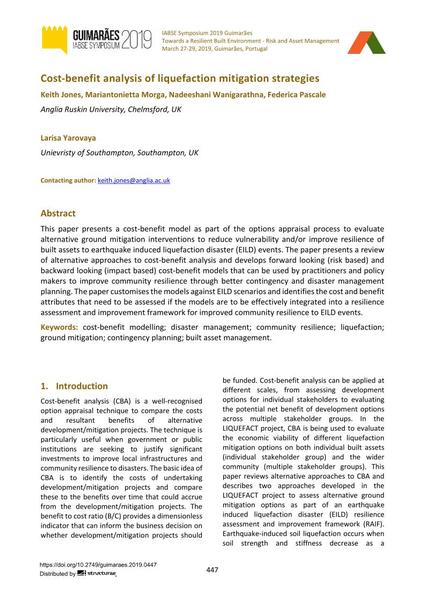Cost-benefit analysis of liquefaction mitigation strategies

|
|
|||||||||||
Bibliographic Details
| Author(s): |
Keith Jones
(Anglia Ruskin University, Chelmsford, UK)
Mariantonietta Morga (Anglia Ruskin University, Chelmsford, UK) Nadeeshani Wanigarathna (Anglia Ruskin University, Chelmsford, UK) Federica Pascale (Anglia Ruskin University, Chelmsford, UK) Larisa Yarovaya (Unievristy of Southampton, Southampton, UK) |
||||
|---|---|---|---|---|---|
| Medium: | conference paper | ||||
| Language(s): | English | ||||
| Conference: | IABSE Symposium: Towards a Resilient Built Environment Risk and Asset Management, Guimarães, Portugal, 27-29 March 2019 | ||||
| Published in: | IABSE Symposium Guimarães 2019 | ||||
|
|||||
| Page(s): | 447-454 | ||||
| Total no. of pages: | 8 | ||||
| DOI: | 10.2749/guimaraes.2019.0447 | ||||
| Abstract: |
This paper presents a cost-benefit model as part of the options appraisal process to evaluate alternative ground mitigation interventions to reduce vulnerability and/or improve resilience of built assets to earthquake induced liquefaction disaster (EILD) events. The paper presents a review of alternative approaches to cost-benefit analysis and develops forward looking (risk based) and backward looking (impact based) cost-benefit models that can be used by practitioners and policy makers to improve community resilience through better contingency and disaster management planning. The paper customises the models against EILD scenarios and identifies the cost and benefit attributes that need to be assessed if the models are to be effectively integrated into a resilience assessment and improvement framework for improved community resilience to EILD events. |
||||
| Keywords: |
liquefaction disaster management cost-benefit modelling community resilience ground mitigation contingency planning built asset management
|
||||
